Highclere Castle
Highclere Castle /ˈhaɪklɪər/ is a country house built in the Italianate style by the architect Charles Barry in the 19th century, with a park designed by Capability Brown in the 18th century. The 5,000-acre (2,000 ha) estate is in Hampshire, England, about 5 miles (8 km) south of Newbury, Berkshire. It is the country seat of the Earl of Carnarvon, a branch of the Anglo-Welsh Herbert family.[2]
| Highclere Castle | |
|---|---|
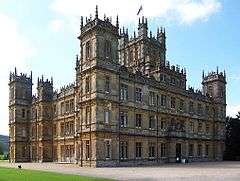 Façade | |
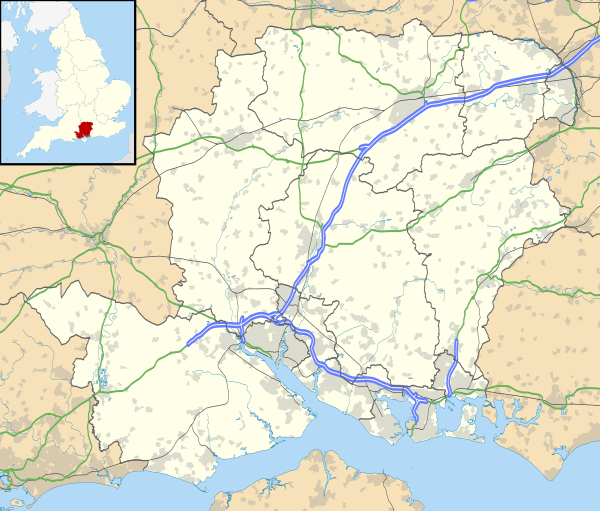 Location within Hampshire | |
| General information | |
| Status | Grade I listed[1] |
| Type | Stately home |
| Architectural style | Jacobethan ("Jacobean Revival") |
| Location | Highclere, Hampshire |
| Coordinates | 51.326667°N 1.361389°W |
| Completed | 1679 |
| Renovated | 1842–49 |
| Owner | George Herbert, 8th Earl of Carnarvon |
| Website | |
| www | |
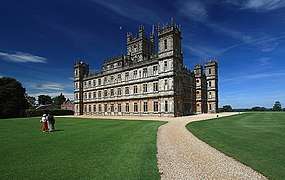
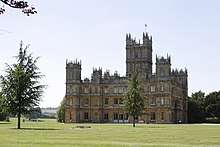
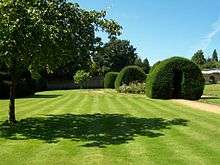
Highclere Castle has been used as a filming location for several films and television series, including 1990s comedy series Jeeves and Wooster, and achieved international fame as the main location for the historical drama series Downton Abbey (2010–15) and the 2019 film based on it.
The house, Egyptian exhibition, and gardens are open to the public for self-guided tours during the summer months and at other times during the rest of the year, such as Christmas and Easter.[3] The house also holds ticketed events, such as the Battle Proms picnic concert, and special guided tours throughout the year.[3]
History
Early years
The house stands on the site of an earlier house, which was built on the foundations of the medieval palace of the Bishops of Winchester, who owned this estate from the 9th century.[4] The original site was recorded in the Domesday Book.[5]
Edward II
An itinerary of King Edward II lists him as spending 2 September 1320 with Rigaud of Assier, the Bishop of Winchester, at Bishop's Clere, alias Highclere. The same tour has him on 31 August 1320 at Sandleford Priory, where he apparently stayed for the night,[6] and on 29 and 30 August he was at Crookham, Berkshire.[7]
Robert Sawyer
The palace was rebuilt as Highclere Place House in 1679 when it was purchased by Sir Robert Sawyer, the Attorney General to Charles II and James II, who was a lawyer, MP, Speaker, and college friend of Samuel Pepys.[8] In 1692, Sawyer bequeathed the mansion at Highclere to his only daughter, Margaret, the first wife of the 8th Earl of Pembroke. Their second son, Robert Sawyer Herbert, inherited Highclere, began its portrait collection and created the garden temples. His nephew and heir Henry Herbert was created Baron Porchester and later Earl of Carnarvon by George III.
Milles and Pococke families
In 1680 Sir Robert Sawyer presented the living of Highclere to the Rev. Isaac Milles (1638–1720), the elder, who remained there till his death. White Oak was the parsonage where Milles took pupils, including the many children of Thomas Herbert, 8th Earl of Pembroke, by marriage the new proprietor of Highclere. The Rev. Isaac Milles (fl. 1701–1727), the younger,[9] carried on his father's school at Highclere.[10] The daughter of Milles, the younger, Elizabeth married Reverend Richard Pococke,[11] LL.B. (1660–1710) and had the Rt. Rev. Richard Pococke (1704–1765), who having been educated by his grandfather Milles, at his school at Highclere rectory, went on to become domestic chaplain to the Philip Stanhope, 4th Earl of Chesterfield, and then Bishop of Ossory and Meath, and a renowned travel writer and orientalist.
Bishop Pococke was one of the first to collect seeds of the Cedar of Lebanon which he did during his tour of Lebanon in 1738.[12] Some of these seeds germinated and grew at Highclere and Wilton House, but probably also at nearby Sandleford and his family's own Newtown House, Hampshire.[13][14]
Coincidentally, the seemingly unrelated and earlier Rev. Edward Pococke (1604–1691), another orientalist, was sometime vicar of Chieveley, and then rector of Childrey both nearby in Berkshire, was an even earlier importer of the cedar.[15] And of his six sons, the eldest, Edward Pococke (1648–1727) was chaplain to the Earl of Pembroke, and rector of Minall or Mildenhall, Wiltshire (1692), and canon of Salisbury (1675).[16]
William Cobbett's description
William Cobbett (1763–1835) in his journal of 2 November 1821, while at Hurstbourne Tarrant wrote:[17]
I came from Berghclere this morning, and through the park of Lord Caernarvon, at Highclere. It is a fine season to look at woods. The oaks are still covered, the beeches in their best dress, the elms yet pretty green, and the beautiful ashes only beginning to turn off. This is, according to my fancy, the prettiest park that I have ever seen. A great variety of hill and dell. A good deal of water, and this, in one part, only wants the colours of American trees to make it look like a creek; for the water runs along at the foot of a steepish hill, thickly covered with trees, and the branches of the lowermost trees hang down into the water and hide the bank completely.
I like this place better than Fonthill, Blenheim, Stowe, or any other gentleman's grounds that I have seen. The house I did not care about, though it appears to be large enough to hold half a village. The trees are very good, and the woods would be handsomer if the larches and firs were burnt, for which only they are fit. The great beauty of the place is, the lofty downs, as steep, in some places, as the roof of a house, which form a sort of boundary, in the form of a part of a crescent, to about a third part of the park, and then slope off and get more distant, for about half another third part. A part of these downs is covered with trees, chiefly beech, the colour of which, at this season, forms a most beautiful contrast with that of the down itself, which is so green and so smooth! From the vale in the park, along which we rode, we looked apparently almost perpendicularly up at the downs, where the trees have extended themselves by seed more in some places than others, and thereby formed numerous salient parts of various forms, and, of course, as many and as variously formed glades. These, which are always so beautiful in forests and parks, are peculiarly beautiful in this lofty situation and with verdure so smooth as that of these chalky downs.
Our horses beat up a score or two of hares as we crossed the park; and, though we met with no gothic arches made of Scotch-fir, we saw something a great deal better; namely, about forty cows, the most beautiful that I ever saw, as to colour at least. They appear to be of the Galway-breed. They are called, in this country, Lord Caernarvon's breed. They have no horns, and their colour is a ground of white with black or red spots, these spots being from the size of a plate to that of a crown-piece; and some of them have no small spots. These cattle were lying down together in the space of about an acre of ground: they were in excellent condition, and so fine a sight of the kind I never saw.'[18]
19th century
The house was then a square, classical mansion, but, after an abortive exterior remodeling by Thomas Hopper in Greek Revival style for the second Earl,[19] it was remodelled and largely rebuilt for the third Earl following a design by Sir Charles Barry[20] in 1842–49[21] during his construction of the Houses of Parliament. It is in the Jacobethan style and faced in Bath stone,[20] reflecting the Victorian revival of English architecture of the late 16th century and early 17th century, when Tudor architecture was being challenged by newly arrived Renaissance architecture influences.
During the 19th century there was a huge Renaissance Revival movement, of which Sir Charles Barry was a great exponent—Barry described the style of Highclere as Anglo-Italian.[22] Barry had been inspired to become an architect by the Renaissance architecture of Italy and was very proficient at working in the Renaissance-based style that became known in the 19th century as Italianate architecture. At Highclere, however, he worked in the Jacobethan style, but added to it some of the motifs of the Italianate style.
This is particularly noticeable in the towers, which are slimmer and more refined than those of Mentmore Towers, the other great Jacobethan house built in the same era. Barry produced an alternative design in a more purely Italian Renaissance style, which was rejected by Lord Carnarvon.[23] The external walls are decorated with strapwork designs typical of Northern European Renaissance architecture. The Italian Renaissance theme is more evident in the interiors. In the saloon, in an attempt to resemble a medieval English great hall, Barry's assistant Thomas Allom introduced a Gothic influence evident in the points rather than curves of the arches, and the mock-hammerbeam roof.[24]
Although the exterior of the north, east and south sides were completed before the 3rd Earl died in 1849 and Sir Charles Barry died in 1860, the interior and the west wing (designated as servants' quarters) were far from complete. The 4th Earl turned to the architect Thomas Allom, who had worked with Barry, to supervise work on the interior of the castle, which was completed in 1878.
The 1st Earl had his park laid out according to a design by Capability Brown in 1774–1777, moving the village in the process—the remains of the church of 1689 are at the south-west corner of the castle. The Lebanon Cedars are believed to be descended from seed brought to England from Lebanon by the 17th century seed collector Edward Pococke.
The founding of Canada
In the 1860s, the 4th Earl drafted the British North America Act of 1867 at the castle alongside the first Prime Minister of Canada John A Macdonald, George-Étienne Cartier and Alexander Tilloch Galt, who signed the visitor book in 1866.[25] The 4th Earl presented the Act to Parliament in February 1867 and this led to the foundation of the present-day nation of Canada later that year.[26]
After the discovery of documents between him and John A. Macdonald, showing eight weeks of nearly daily correspondence, Janice Charette, the Canadian High Commissioner to the United Kingdom, recognized the central role of the 4th Earl in the creation of Canada by planting a maple tree on the lawn on 11 January 2018.[27]
20th century
The castle became home to Egyptian artifacts after the 5th Earl, an enthusiastic amateur Egyptologist, sponsored the excavation of nobles' tombs in Deir el-Bahari (Thebes) in 1907.[28] He later accompanied archaeologist Howard Carter during the discovery of the tomb of Tutankhamun in 1922.
During World War II the castle provided a home for dozens of evacuee children. The estate was the location of several crashes of allied aircraft, including a B-17 Flying Fortress parts of which are now in the possession of Highclere.[29]
In 1969, Henry Herbert, 7th Earl of Carnarvon, became racing manager to Elizabeth II.[30] The 7th Earl was "great friends" with the Queen; she was a "frequent visitor until his death in 2001".
21st century
In 2003, Lord and Lady Carnarvon undertook major roof repairs.[31] In 2007, Lord and Lady Carnarvon created the Egyptian Exhibition, which lies in the cellars of the castle and tells the story of the discovery of Tutankhamen by the 5th Earl.[31]
By 2009, the castle was again in need of major repair, with only the ground and first floors remaining usable. Water damage had caused stonework to crumble and ceilings to collapse; at least 50 rooms were uninhabitable. The 8th Earl and his family were living in a "modest cottage in the grounds"; he said a lack of repair by his ancestors caused the castle's long term problems. As of 2009, repairs needed for the entire estate were estimated to cost around £12 million, £1.8 million of which was urgently needed just for the castle.
From 2010, the castle was used as the main filming location for the ITV/PBS drama series Downton Abbey, which brought the castle international fame.[32][33]
As of late 2012, Lord and Lady Carnarvon said that an increase in the number of paying visitors allowed them to begin major repairs on both Highclere's turrets and its interior. The family attributed this increase in interest to the on-site filming of Downton Abbey.[34] The family now live in Highclere Castle at various times throughout the year, but return to their cottage when the castle is open to the public.
Highclere Park
The parkland surrounding the castle is listed Grade I on the Register of Historic Parks and Gardens and is listed as a Site of Special Scientific Interest (SSSI).[35][36]
The park is the earliest documented estate in Hampshire, having been given in 749 to the Church of Winchester as a deer park.[35][37] In 1706, under the ownership of Robert Sawyer Herbert, the park became a Rococo landscape of walks.[35] Then in 1770 it became a landscaped park designed by Capability Brown.[37]
In 1991 Highclere Park was registered as an SSSI.[38] The park's listing as a SSSI is due to a mixture of habitats that contain many regional uncommon plants, and its diverse range of lichen.[36][37]
Details
There are various follies on the estate. To the east of the house is the Temple of Diana, erected before 1743 with Ionic order columns from Devonshire House in Piccadilly, which had burnt in 1733, and remodeled by Barry.[39] "Heaven's Gate" is a folly about 60 feet high on Sidown Hill, built in 1749 by Hon. Robert Sawyer Herbert (d. 1769). Other 18th-century follies that can be found on the grounds of the estate include Milford Lake House and Jackdaw's Castle, both attributed to the architect-earl of Pembroke, brother of the owner,[40] and the Etruscan Temple.
The hybrid holly Ilex x altaclerensis (Highclere holly) was developed here in about 1835 by hybridising the Madeiran Ilex perado (grown in a greenhouse) with the local native Ilex aquifolium.
%2C_brick_but_Coade_stone_dressed%2C_and_wings_(1840)%2C_Highclere_Castle%2C_Hampshire%2C_May_2014.jpg)
The castle, Egyptian exhibition and gardens are open to the public during the summer months and at other times during the rest of the year.[42] The castle also holds special ticketed events throughout the year.[43]
As film and television location
- 1982: It was seen as the home of a wealthy Englishman that Mr Fortescue visited seeking money in the 1982 film starring Michael Palin, The Missionary[44]
- 1987: Shots from both the interior and exterior were used as the imposing Misselthwaite Manor in the Hallmark Hall of Fame's 1987 TV film The Secret Garden.[45] The same was the case for the film Poor Little Rich Girl: The Barbara Hutton Story (1987), which starred Farrah Fawcett.
- 1990–1993: Totleigh Towers, in the TV series Jeeves and Wooster, was represented by Highclere Castle.
- 1991: The exterior appeared as Lord Graves's house in the film King Ralph.[46]
- 1991: Kevin Reynolds' Robin Hood: Prince of Thieves.
- 2001: The interior and exterior were used again as Misselthwaite Manor in the movie Back to the Secret Garden.
- 2002: The salon appeared in the film The Four Feathers starring Heath Ledger.[47]
- 2004: Used in Agatha Christie's Marple as Rutherford Hall in the episode "4:50 From Paddington".
- 2006: John Legend's 2006 music video for "Heaven" featured the castle.
- 2010–2015: The main setting for the British television period drama Downton Abbey.[20] The Tatler referred to the area around Highclere as "Downtonia".[48] The great hall, dining room, library, music room, drawing room, salon and several of the bedrooms were used for filming.
- 2018: Used for the film adaptation of Downton Abbey, released in 2019.[49][50][51]
As event venue
In 2007, the grounds were the venue for the Countryside Rocks concert, to raise funds for the U.K. rural advocacy organisation Countryside Alliance, featuring Bryan Ferry, Steve Winwood, Eric Clapton, Steve Harley and Kenney Jones.[52]
See also
- Canadian Confederation
- Other Downton Abbey filming locations:
References
- "Highclere Castle, Highclere". British Listed Buildings. Retrieved 5 October 2011.
- Highclere Castle. "Highclere Castle". highclerecastle.co.uk. Archived from the original on 25 May 2011.
- "Highclere Castle Opening Times and Visitor Information". www.highclerecastle.co.uk. Retrieved 26 August 2019.
- Highclere Castle. "Highclere Castle & Gardens". highclerecastle.co.uk.
- OpenDomesday.org. "Domesday Book – Highclere". OpenDomesday.org.
- tarried is the word used in the records quoted by Walter Money.
- Walter Money, Newbury, page 160.
- "Highclere Castle". www.highclerecastle.co.uk.
- BA of Balliol College (1696), MA from Sidney Sussex, Cambridge (1701), treasurer of the diocese of Waterford 21 May 1714, and non-resident prebendary of Lismore, County Waterford 6 September 1716.
- And resigned his Irish benefices in 1727 to become rector of nearby Ludshelfe or Litchfield, Hampshire.
- Headmaster of the King Edward VI Free Grammar School, and curate, under sequestration, of All Saints' Church in Southampton. Son of another Richard Pococke, LL.B., rector of Colmer, Hampshire, from 1660 to his death in 1719.
- He reached Dendereh on 9 January 1738.
- History of Newtown by Doug Ellis, Newtown Parish Council, 2015.
- F. Nigel Hepper, in Arboricultural Journal: The International Journal of Urban Forestry, Volume 25, Issue 3, 2001 : THE CULTIVATION OF THE CEDAR OF LEBANON IN WESTERN EUROPEAN PARKS AND GARDENS FROM THE 17TH TO THE 19TH CENTURY.
- Nigel Hepper in the abstract to his 2001 article (ibid): 'The earliest extant cedar in England is Edward Pocock's at Childrey. Oxfordshire (c. 1642).'
- DNB
- "Cobbett's Rural Rides". London. June 1853.
- Cobbett continues: ' Upon leaving the park, and coming over the hills to this pretty vale of Uphusband [Huphusseburn, Hurstbourn], I could not help calculating how long it might be before some Jew would begin to fix his eye upon Highclere, and talk of putting out the present owner, who, though a Whig, is one of the best of that set of politicians, and who acted a manly part in the case of our deeply injured and deeply lamented queen. Perhaps his lordship thinks that there is no fear of the Jews as to him. But does he think that his tenants can sell fat hogs at 75. 6d. a score, and pay him more than a third of the rent that they have paid him while the debt was contracting? I know that such a man does not lose his estate at once; but, without rents, what is the estate? And that the Jews will receive the far greater part of his rents is certain, unless the interest of the debt be reduced. Lord Caernarvon told a man, in 1820, that he did not like my politics. But what did he mean by my politics? I have no politics but such as he ought to like..."
- Howard Colvin, A Biographical Dictionary of British Architects, 1600–1840, 3rd ed. 1995, sv "Hopper, Thomas" p. 515.
- Dickson, Elizabeth (January–February 1979). "Historic Houses: The Splendors of Highclere Castle". Architectural Digest. Retrieved 2 January 2013.
- Colvin 1995, sv "Barry, Sir Charles" p. 104; Barry had earlier remodeled the circular Ionic Temple of Diana in the park (drawings dated 1838 at Highclere).
- Henry Russell Hitchcock (1958) Architecture: Nineteenth and Twentieth Centuries (Pelican History of Art), London, Penguin Books, p.73.
- Roger Dixon and Stefan Muthesius. Victorian Architecture. Thames and Hudson 1978, pp.39–40
- "Highclere Castle, Earl of Carnarvon, Egyptian antiquities, State Rooms". Highclerecastle.co.uk. Retrieved 30 September 2012.
- "Community Category: Highclere and Canada". Lady Carnarvon. Retrieved 19 June 2018.
- International, Radio Canada (11 January 2018). "Downton Abbey: where Canada's Constitution was created". RCI | English. Retrieved 19 June 2018.
- "Maple tree planted at 'Downton Abbey' castle in tribute to Canada's founding". CTVNews. 11 January 2018. Retrieved 19 June 2018.
- A letter from Gaston Maspero dated 14 October 1907, contained in the archives of Maspero in the library of the Institut de France says, "You have been kind enough to say to me that you could find a man who knows Egyptology to survey my works. Have you thought to anybody? I will leave the question of payment in your hands but I think I would prefer a compatriot" (Manuscripts 4009, folios 292–293). On 16 January 1909, Carter wrote to Maspero, "Just a word to tell you that Lord Carnarvon has accepted my conditions. He will be there (in Egypt) from 12 February to 20 March. I have to thank you again..." (Manuscripts 4009, folio 527) – from Elisabeth David.
- "The Countess of Carnarvon and the real Downton Abbey". 11 June 2014. Retrieved 22 November 2017.
- Charles Mosley, editor, Burke's Peerage, Baronetage & Knightage, 107th edition, 3 volumes (Wilmington, Delaware, U.S.A.: Burke's Peerage (Genealogical Books) Ltd, 2003), volume 1, p. 698
- "Finding Downton: Our Journey to Highclere Castle". Anglotopia.net. Retrieved 26 August 2019.
- Rodrigues, Cecilia (2 January 2016). "Downton Abbey: The End Is Near For The Series But The Real Mansion Is Forever". Forbes. Retrieved 23 April 2020.
- "Highclere Castle of Downton Abbey fame opens bedroom for rent through AirBnB". ABC 7 News. 18 September 2019. Retrieved 23 April 2020.
- Brown, Maggie (19 September 2015). "How Downton Abbey helped to rescue Highclere Castle from ruin". The Guardian. Retrieved 23 April 2020.
- Historic England, "Highclere Park (1000109)", National Heritage List for England, retrieved 10 September 2017
- "Village Design Statement Highclere and Penwood 2002" (PDF). Basingstoke Council.
- "SITE:Highclere Park SSI" (PDF). Natural England.
- "Highclere Park SSSI". Natural England.
- Colvin 1995, sv "Herbert, Henry, 9th Earl of Pembroke" p. 491.
- Colvin 1995 p. 491.
- "London Lodge, Highclere". britishlistedbuildings.co.uk.
- "Opening Times. visitor information, Highclere Castle". www.highclerecastle.co.uk. Retrieved 19 June 2018.
- "Admission Tickets to Highclere Castle". highclerecastleshop.co.uk. Retrieved 19 June 2018.
- https://www.imdb.com/title/tt0083449/ IMDB, see "Details" section
- Williams, George (29 November 1987). "Filming 'Secret Garden' was a nightmare". McClatchy News Service..
- King Ralph UK filming locations.
- The Four Feathers UK filming locations.
- The Tatler, January 2011.
- "Downton Abbey FILM slated for summer 2018". Daily Express. 17 December 2017. Retrieved 14 July 2018.
- "DOWNTON ABBEY MOVIE CONFIRMED". Highclere castle. 5 August 2018. Retrieved 12 August 2018.
- Desta, Yohana (13 July 2018). "It's Happening: Downton Abbey's Original Cast Is Reuniting for a Movie". Vanity Fair: HWD. Retrieved 15 December 2018.
- Cheal, David (22 May 2007). "Rock's aristocrats show their class". The Daily Telegraph. London. Retrieved 15 August 2015.
External links
| Wikimedia Commons has media related to Highclere Castle. |
- Official website
- Lady Carnarvon - The official website of the Countess of Carnarvon
- Highclere Castle entry from The DiCamillo Companion to British & Irish Country Houses
- Highclere Castle on The Internet Movie Database
- "Take a guided tour around the real Downton Abbey". The Daily Telegraph. 7 October 2011. Retrieved 16 February 2012.